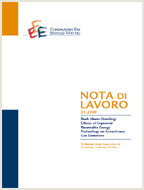On the Interaction between Player Heterogeneity and Partner Heterogeneity in Two-way Flow Strict Nash Networks

Date
15.05.2015
15.05.2015
Authors
Banchongsan Charoensook (Keimyung University)
JEL Code
C72, D85
C72, D85
Keywords:
Network Formation, Strict Nash Network, Two-way Flow Network, Branching Network, Agent Heterogeneity
Network Formation, Strict Nash Network, Two-way Flow Network, Branching Network, Agent Heterogeneity
Publisher
Climate Change and Sustainable Development
Climate Change and Sustainable Development
Editor
Carlo Carraro
Carlo Carraro
This paper brings together analyses of two-way flow Strict Nash networks under exclusive player heterogeneity assumption and exclusive partner heterogeneity assumption. This is achieved through examining how the interactions between these two assumptions influence important properties of Strict Nash networks. Built upon the findings of Billand et al (2011) and Galleotti et al (2006), which assume exclusive partner heterogeneity and exclusive player heterogeneity respectively, I provide a proposition that generalizes the results of these two models by stating that: (i) Strict Nash network consists of multiple non-empty components as in Galleotti et al (2006), and (ii) each non-empty component is a branching or Bi network as in Billand et al (2011). This proposition requires that a certain restriction on link formation cost (called Uniform Partner Ranking), which encloses exclusive partner heterogeneity and exclusive player heterogeneity as a specific case, is satisfied. In addition, this paper shows that value heterogeneity plays a relatively less important role in changing the shapes of Strict Nash networks.
***
Suggested citation: Charoensook, B., (2015), ‘On the Interaction between Player Heterogeneity and Partner Heterogeneity in Two-way Flow Strict Nash Networks’, Nota di Lavoro 44.2015, Milan, Italy: Fondazione Eni Enrico Mattei.
